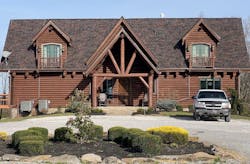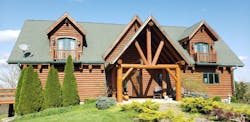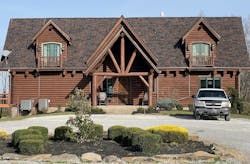Industry shows are always a good way to take the “pulse” of the contracting business. During the most recent International Roofing Expo (IRE) in Dallas, it was great to see contractors handling shingles, putting roofing materials to the nailing zone test, and checking out videos showing how roofs stood up to the fury imposed by extreme weather events.
But what really struck me as I watched contractors voting for their favorite new shingle color was what a big deal color has become on a home’s exterior, especially on the roof. When a purple-infused shingle (“Midnight Plum”) was the top vote-getter at a digital polling station, it was obvious that contractors in 2023 are thinking far beyond shades of gray for residential roofs.
The following are four colorful takeaways from IRE that underscore the role color is playing as a from-the-top exterior style statement.
1. Design and inspire tools are changing the roofing color conversation.
While color has long been viewed as an easy way to transform a home’s exterior via siding, paint, front doors, and trim, the roof has often been left out of color considerations. After all, roofing contractors are in the business of selling a roof, not consulting on color, and too often the assumption has been made that a black or brown roof would be replaced with another black or brown roof.
A large roofing manufacturer has conducted focus groups with women to glean insights into how they make home color and style decisions. During these focus groups, respondents have shared that bringing up the color conversation with contractors can feel awkward.
Installing a shingle that expresses a homeowner’s personal style and boosts curb appeal through the power of color can elevate the customer’s satisfaction even more.
Shingle manufacturer initiatives strive to bridge the color gap in the homeowner-contractor conversation. Exterior design and style boards help elevate the conversation beyond performance and function and help position the roof as prime real estate that can boost curb appeal. After all, depending on the slope and style, a home’s roof can represent a significant portion of the exterior. Beyond style boards, technologies like color visualizers make it easy for homeowners to visually “try on” different roof colors using a photo of their own home or a template image.
So how can a remodeler bring the conversation around to color? A simple question like, “What do you think of the color you’ve got on your roof now?” can reveal whether a change is in order. If a homeowner responds with, “Well, it’s OK, I guess,” that’s an opportunity for the contractor to inquire, “Is there something else you’d like to consider?” and direct the homeowner to online style boards that can inform their decision.
2. Color can help turn a roof replacement into an exterior makeover.
Color can be the unifying element in a phased exterior transformation. For example, a change in siding color can be amplified when paired with a new roof color. This multi-improvement opportunity begs the question of which exterior improvement should be tackled first.
If a roof is leaking or damaged, the first priority should be to replace the roof to avoid interior damage and the potential hazard to occupants. If the homeowner’s budget doesn’t allow for new siding immediately after replacing the roof, a plan can be developed to phase in exterior design elements. Simply painting the front door to coordinate with the roof or adding porch furniture can help bring a more cohesive color vibe to the exterior until the exterior design plan is fully achieved.
3. Shingle color isn’t localized; it’s personal.
During IRE and throughout the year, I get questions asking if certain shades are more popular in some regions. Despite common perceptions about region and tones, color comes down to personal preference.
Case in point: The log cabin-style home in the accompanying photo isn’t from the Smoky Mountains or Pacific Northwest but from the Midwest. The “Bourbon” shingle ties the exterior together in a rich, understated way that’s as “at home” in southern Ohio as it would be in a more mountainous region.
Similarly, sea-inspired shades of blue perform very well in central parts of the country and aren’t restricted to coastal regions. While some might expect a purple-infused shingle to be more popular in urban areas or regions renowned as creative hotspots, it has performed well across all regions, as evidenced by contractors’ sales data.
The bottom line is that color is personal and as people migrate to other parts of the country, they apply their favorite colors to their new homes.
4. Roof performance still matters.
At the end of the day, a home’s roof has to go beyond beauty. The shingles protecting a home must stand up to the stressors of weather in all seasons. From listening to contractors at IRE, it's clear that storm season is every season.
Resistance to the impact of hail, blistering summer heat, and year-round winds means that materials on the roof must perform all year. Selecting a shingle designed to perform and protect a home and its occupants will always be a de facto priority for roofing contractors.
Installing a shingle that expresses a homeowner’s personal style and boosts curb appeal through the power of color can elevate the customer’s satisfaction even more.
Sue Burkett is a marketing manager and senior color expert at Owens Corning. She led Owens Corning’s Shingle Color of the Year initiative launched in 2017 and continues to work with remodelers, roofing contractors, and designers to boost homes’ curb appeal through a wide range of beautiful shingle colors. For more insight on roofing color and design, visit: www.owenscorning.com/en-us/roofing/design-inspire


